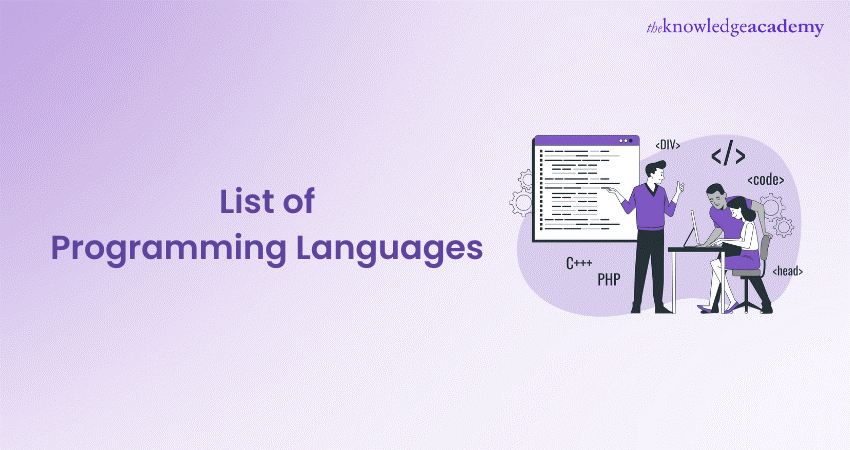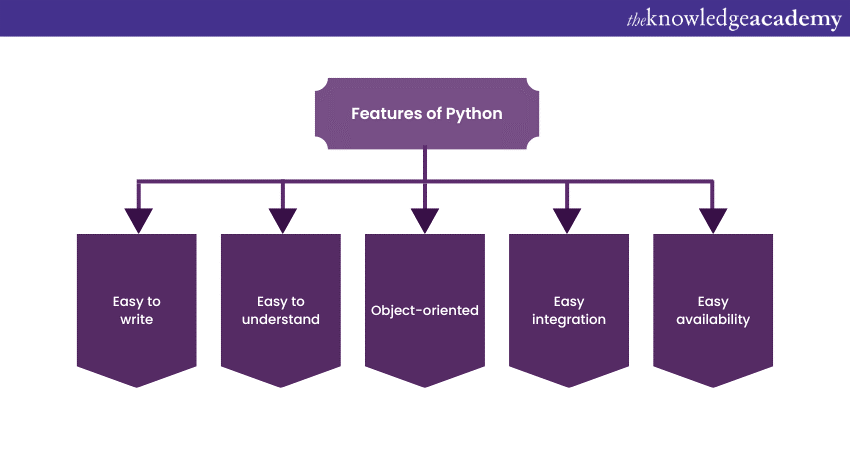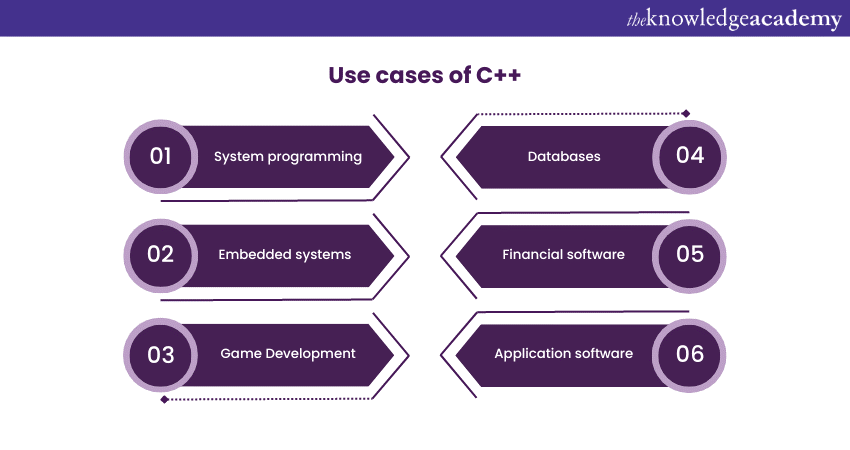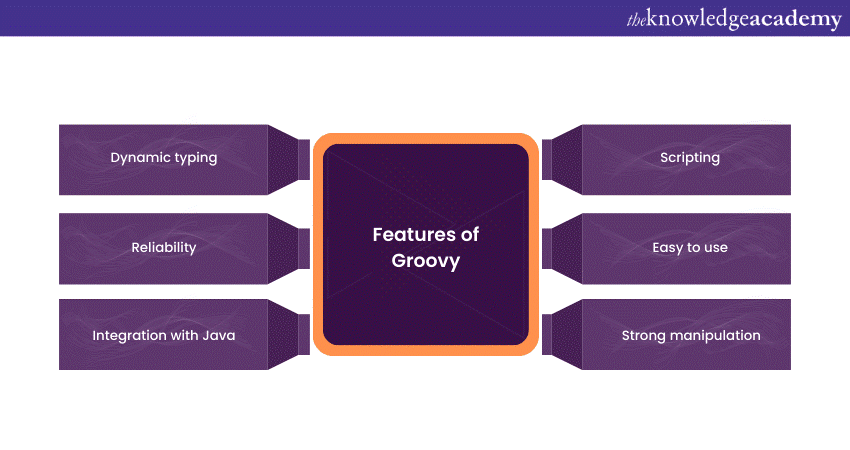We may not have the course you’re looking for. If you enquire or give us a call on +918037244591 and speak to our training experts, we may still be able to help with your training requirements.
We ensure quality, budget-alignment, and timely delivery by our expert instructors.

As the software industry keeps evolving, the need for efficient programmers is in high demand. Programmers then select a language from the List of Programming Languages to carry out their tasks effectively. The selection of languages is based on various criteria and use cases, such as the nature of the project, scalability, etc.
Data from Statista shows that JavaScript and HTML/CSS were the most used programming languages among software developers around the world in 2022. with more than 63.6 per cent using JavaScript and around 53 per cent using HTML/CSS. This comprehensive List of Programming Languages covers the 18 most popular, niche, and historical languages that provide insights into the diverse world of coding.
Table of Contents
1) What is a Programming Language?
2) List of Programming Languages
a) Python
b) Java
c) JavaScript
d) C
e) C++
f) Assembly Language
g) SQL
h) Objective-C
i) Ruby
j) Rust
3) Conclusion
What is a Programming Language?
A Programming Language is used for communicating with a computer and to make it perform certain tasks according to the commands. It is similar to how humans communicate and exchange ideas through different languages. Computers use different languages to communicate between users and themselves.
Unlock the power of programming through our carefully crafted Coding Training Course. Sign up today!
Top 18 Programming Languages
There are various Programming Language programmers who use it according to the use cases and scenarios. This section will deal with 18 of the most commonly used and popular Programming Languages. The section also gives you an insight into why these languages are popular, their use case scenarios and their significance in the Information Technology industry.
Python
Python is a highly interpreted language developed in 1989. It was created by Guido Van Rossum. Python supports Object-Oriented Capability and Memory management. It is known for its easy-to-read and write syntax, making it one of the most popular languages today and one of the most sought-after backend programming languages. Many developers compare the R Programming Language and Python for their powerful data processing capabilities.
Python is mainly used for artificial intelligence and web applications. Python is in high demand for various jobs and is one of the top-paying programming languages. Finding a job with Python proficiency is very easy and has significant needs and a scalable future.
Here’s a sample code in Python:
print("Hello, World!")

Java
Java is a high-level language which is used for general purposes. It was developed by Sun Microsystems in 1991. Today, it is one of the most popular and relevantly used languages in various industries and academic institutions. Its memory management and cross-platform compatibility are the main features that make it a popular programming language.
Memory management helped Java minimise the dependence on developers to delete unused memory when it is not in use. Using automated garbage collection made sure that developers didn't have to worry about the memory management scenario.
Java can be easily used on various platforms or Operating Systems without any compatibility issues because of its cross-platform compatibility. This compatibility made Java popular among the Programming Languages. If you are planning to build a career in web development, app development, embedded systems, etc., Java is a language to learn.
Here’s a sample code in Java:
|
public class HelloWorld { public static void main(String[] args) { System.out.println("Hello, World!"); } } |
Output: Hello, World!
JavaScript
JavaScript is a top-level interpreted language that runs in the browser. It was created by Brendan Eich. It was first rolled out in the year of 1995. It is one of the most popular programming languages in the world, particularly for the internet. In the present world, it has become a major powerhouse. JavaScript is the language used in most popular websites around the globe.
JavaScript is famous for its convenient way of learning and its widespread usage. Many features, such as in the Version of NodeJS and TypeScript, are based on JavaScript syntax. It is considered one of the market's most valuable and widely used languages. If you are familiar with OOP concepts, it is also suggested that you look into the typescript. TypeScript makes good use of OOP concepts and compiles them into native JavaScript.
Here’s a sample code in Java:
console.log("Hello, World!");
Output: Hello, World!
Explore our detailed guide on PHP VS JavaScript and find out which technology is best suited for your project!
C
C is considered one of the oldest programming languages, which is a high-level language. It was developed by Dennis Ritchie in AT&T Bell Laboratories in 1972. C is the most commonly used language for lower-level components in software. It is similar to Kernal in an OS. C is also in high demand for the programming of embedded systems. For circumstances where speed matters the most, C is the preferred language.
C is considered one of the best Programming Languages for beginners to learn. It is also used in academic institutions for teaching purposes. If you are looking for a future in Kernel Programming or Hardware Programming, C is preferred. Also, there can be some similarities with the C++ language because it's an upgraded version of C.
Here's a simple "Hello, World!" program in the C programming language:
|
int main() { printf("Hello, World!n"); return 0; } |
Output: Hello, World!
C++
C++ is the successor of C with various object-oriented features. It was first introduced in the early 1980s by Bjarne Stroustrup. It was popularly used for Hardware Programming, and it consists of multiple libraries. It is one of the programming languages that is in high demand among beginners trying to learn object-oriented concepts.
It is also known for its ability to create game engines and is also a popular game Programming Language. The scope of C++ will be similar to that of C as both share the same concepts.
Here's a sample "Hello, World!" program in C++:
|
int main() { std::cout << "Hello, World!" << std::endl; return 0; } |
Output: "Hello, World!

Assembly Language
Assembly language is known for its significance in embedded programs or hardware programming. Kathleen Booth developed the first Assembly Language in 1947 for ARC2. It changes depending on the given microprocessor. Since the language is basically an instruction set of a given microprocessor, it varies according to the microprocessor.
Unlike other regular languages, the programmer here has to understand the details of the microprocessor, like its instruction set, data sizes, registers etc., to work smoothly. It is used majorly to improve the performance of software. The scope is extensive as it opens the gate for people who are skilled at systems programming/hardware programming as it requires the knowledge of Assembly Language.
Here's a simple "Hello, World!" program written in x86 assembly language for a Windows operating system using the NASM assembler:
|
section .data hello db 'Hello, World!',0 ; Null-terminated string to be printed section .text global _start ; Entry point for the program _start: ; Write "Hello, World!" to stdout (file descriptor 1) mov eax, 4 ; syscall number for sys_write mov ebx, 1 ; file descriptor 1 (stdout) mov ecx, hello ; pointer to the string mov edx, 13 ; length of the string int 0x80 ; interrupt to invoke syscall ; Exit the program mov eax, 1 ; syscall number for sys_exit xor ebx, ebx ; exit status, 0 int 0x80 ; interrupt to invoke syscall |
Output: Hello, World!
SQL
SQL is a query language which is frequently used for data querying and manipulation. It is frequently used for Relational Database Management Systems (RDBMS). It was created by Raymond Boyce and Donald Chamberlin in the 1970s. It is not a language which is directly used to write applications; instead, it is used to access databases to read, fetch or update existing data. Even though it is an important language in the software industry, it isn’t a necessary skill set for any job.
It can be difficult for you to learn SQL if you are unfamiliar with programming or database concepts. SQL, while compared to other databases, can be on the slower side as it is not well suited for complex tasks such as Machine Learning or complex Data Analysis.
Unlike other traditional Programming Languages, SQL doesn't write a traditional "Hello, World!" Program. You can use SQL to retrieve a "Hello, World!" message from a database. Here's an example of how you might do that:
|
-- and a row with 'Hello, World!' as the message text SELECT message_text FROM messages WHERE message_id = 1; |
Objective-C
Objective-C is a Programming Language that was mainly used to develop software for Apple's products like iPhones, iPads, and Mac computers. It is famous for its unique syntax and was one of the main languages used for Apple app development before Swift was developed.
Here's a simple "Hello, World!" program in Objective-C:
|
int main(int argc, const char * argv[]) { @autoreleasepool { NSLog(@"Hello, World!"); } return 0; } |
Output: Hello, World!
Ruby
Ruby was developed by Yukihiro "Matz" Matsumoto in the mid-1990s. It is an object-oriented programming language that was inspired by various other languages such as Pearl, Ada, Lisp, etc. It is popular for its web development feature. It also offers ease of learning, which is useful for beginners as well as users who are into web development.
Ruby on Rails (RoR) is a web application framework implemented in Ruby. Attributes like these have led to a large community of Ruby developers growing interest in the language.
Here's a "Hello, World!" program written in the Ruby Programming Language:
puts "Hello, World!"
Output: Hello, World!
Gain knowledge of Ruby Programming Language and learn to write, modify, maintain and understand Ruby scripts through our Ruby Programming Course. Sign up today!
Rust
Rust was developed by Graydon Hoare in 2006. It is a comparatively new programming language that is highly reliable and powerful. One of the most important features of Rust is its safety, which is highly applauded.
The major drawback of Rust is its complexity and high learning curve. Only a few people use it, and it is not recommended as a primary language. It is difficult to integrate with existing codebases using Rust as it only supports a few platforms.
Here's a simple "Hello, World!" program written in Rust:
|
fn main() { println!("Hello, World!"); } |
You can compile and run this code using the Rust compiler. Make sure you have Rust installed, and then proceed to save this block of code to a file with a .rs extension (e.g., hello.rs), and run the following commands in your terminal:
|
$ ./hello |
Output: Hello, World!
Julia
Julia is a new Programming Language developed by Jeff Bezanson, Stefan Karpinski, Viral B. Shah, and others in 2012. Julia is mainly used for numerical and analytics purposes. It was created to meet the need for a Programming Language that is easy to use and performs high-end tasks like Data Analysis, Machine Learning, scientific calculations, etc.
Here's a simple "Hello, World!" program in Julia:
println("Hello, World!")
Output: Hello, World!
Groovy
Groovy was developed by James Strachan in 2003. It is a Programming Language that is closely associated with Java. It is popular for its ease of usability, high reliability and hassle-free integration with Java. It also offers features such as dynamic typing and operator overloading, which are not present in Java.
Groovy is also a scripting language, as it can be uncompiled. It performs a variety of tasks, from quick scripting to developing large-scale applications. It is well-suited for projects where rapid development and integration with Java are essential. Even though Groovy isn’t a basic requirement in any of the jobs out there, it is still listed in many job descriptions.

Given below is a "Hello, World!" program in Groovy :
println "Hello, World!"
Output: Hello, World!
R
R is an open-source language developed in the early 1990s. It is a different version of the S language where programmers write for S and run on R without any changes. R is a language that is used to build applications for statistical computing, calculation, visualisation, and analysis of data. Applications made using R can easily process both structured and unstructured data.
It is not a language that is very easy for beginners to learn. However, there is an active community of online members present there to discuss and learn the R language. It is recommended for people who have a strong mathematical background and knowledge of JavaScript or Python.
Here's a sample "Hello, World!" program in the R programming language:
# This is a simple Hello, World! program in R
print("Hello, World!")
Output: Hello, World!
Gain an in-depth knowledge of R programming by signing up for our R Programming Course. Join now!
HTML
HTML (Hyper Text Markup Language) is a Programming Language used for creating web pages on the internet and other applications. It can be used to add images, links and various other content to the web pages. It is very easy to learn to create a basic web page with basic programming knowledge.
Using HTML structures, images and other structures can be added to the page. It is essential for building the foundation of a website and requires the help of other languages to create an interactive web application. It also comes with technologies such as Cascading Style Sheets (CSS) for styling and JavaScript for improving interactivity.
Also, HTML is not a secure language, and it is vulnerable to security threats. Developers must carefully encode to avoid any mishaps. It can create confusion amongst beginners as it involves a lot of different elements and syntax rules.
A sample “Hello World” HTML code is given below:
Hello, World!
|
|
|
This is a basic HTML document.
|
Output: Hello, World!
Perl
Perl is a high-end Unix scripting language developed by Larry Wall in 1987. The primary purpose of Perl was to make the processing of reports easier. One of its popular features is its regular expression support, making it a perfect choice for tasks such as
a) pattern matching
b) string manipulation, and
c) data extraction
Perl runs on various operating systems, such as Windows, macOS, and Linux. This makes it a perfect choice for scripting and automation tasks. The Comprehensive Perl Archive Network (CPAN) provides a lot of pre-written modules that simplify many programming tasks. This helps to save developers' time.
On the other hand, Perl has a very complex syntax, which makes it difficult for beginners. It is also on the slower side for tasks involving CPU-intensive operations. Even though it supports object-oriented programming (OOP), it does not provide built-in support for OOP.
Here's a sample "Hello, World!" program in Perl:
#!/usr/bin/perl
# This is a simple "Hello, World!" program in Perl.
print "Hello, World!n";
Save this code in a file with a .pl extension, such as hello_world.pl. Make sure to give the file executable permissions, and then you can run it from the command line like this:
perl hello_world.pl
Output: Hello, World!
To further enhance your understanding of Perl and its applications, explore our guide on Perl Interview Questions and Answers for deeper insights.
PHP
PHP is a Programming Language that is primarily designed for web development. It is simple to use and is versatile in its own way, making it a suitable option for building websites and web applications. PHP is an open-source language, making it freely available for anyone to use. It makes it easy to mix dynamic and static content easily as it is embedded within an HTML code.
Being an open-source language has its drawbacks as well, such as its inconsistent syntax, which leads to coding errors and its limited performance capability. However, it offers coding benefits like flexibility, support, and integration. With the evolution of other languages, some PHP libraries and frameworks still need to be updated. This does not help programmers as they have to update their choices constantly.
Sample "Hello, World!" program written in PHP is given below:
|
echo "Hello, World!"; ?> |
You can save this code in a .php file and run it on a web server with PHP installed, or you can use a local development environment like XAMPP or WAMP to execute the PHP code.
Output: Hello, World!
F#
Microsoft introduced a Programming Language known as F# in 2005. It combines features of both object-oriented and functional programming. F# compiles into the .NET Intermediate Language (IL). It is mainly used to execute tasks involving data manipulation and scientific computing. It is also known for its simple and effective syntax, as it belongs to the family of functional programming.
It helps programmers write code efficiently with minimal errors as it has a clear and concise way of writing code. F# is popularly used in fields like finance and Data Analysis. If you're someone looking for a language that has the best functional and object-oriented programming, F# might be a great choice for your projects.
A simple "Hello, World!" program in F# is given below:
printfn "Hello, World!"
You can run this code in an F# environment, such as Visual Studio or Visual Studio Code with the F# extension installed.
Output: Hello, World!
Bash
Bash, abbreviated “Bourne Again Shell”, was developed by Brian Fox in 1989. It is a scripting language mostly used to automate tasks on Unix and Linux software. It serves as a powerful tool for interacting with a computer's operating system through text-based commands. It allows users to efficiently:
a) automate tasks
b) manage files and directories
c) execute various system commands
It has a very easy syntax, which makes it easy for beginners to get started with it. Bash has limited support for processing complex data and advanced data manipulation. This makes it less suitable for tasks involving complex data handling.
Here's a simple "Hello, World!" program in Bash:
#!/bin/bash
echo "Hello, World!"
You can create a new file, for example, hello.sh, paste this code into it, and then run the script in your terminal using the following commands:
chmod +x hello.sh # This makes the script executable
./hello.sh # This runs the script
Output: Hello, World!
Conclusion
The above List of Programming Languages is basically a guide that gives you the option to select the language suitable for performing your tasks effectively. The languages discussed in this blog help you understand the various applications and uses of each language. Choosing the right language depending on the kind of project helps you yield better results. We hope you had an insightful reading session on the list of top Programming Languages.
Take a step forward in your coding career by choosing our wide range of courses on Programming Training. Join today!
Frequently Asked Questions
What are the Other Resources and Offers Provided by The Knowledge Academy?

The Knowledge Academy takes global learning to new heights, offering over 3,000 online courses across 490+ locations in 190+ countries. This expansive reach ensures accessibility and convenience for learners worldwide.
Alongside our diverse Online Course Catalogue, encompassing 19 major categories, we go the extra mile by providing a plethora of free educational Online Resources like News updates, Blogs, videos, webinars, and interview questions. Tailoring learning experiences further, professionals can maximise value with customisable Course Bundles of TKA.
Upcoming Programming & DevOps Resources Batches & Dates
Date
 Coding Training Course
Coding Training Course
Fri 11th Apr 2025
Fri 13th Jun 2025
Fri 15th Aug 2025
Fri 10th Oct 2025
Fri 12th Dec 2025






 Top Rated Course
Top Rated Course



 If you wish to make any changes to your course, please
If you wish to make any changes to your course, please


